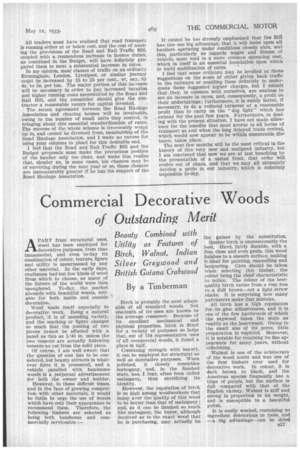Commercial Decorative Woods
Page 45

Page 46

If you've noticed an error in this article please click here to report it so we can fix it.
of Outstanding Merit
Beauty Combined with Utility as Features of Birch, Walnut, Indian Silver Greywood and British Guiana Crabwood By a Timberman
APART from structural uses, wood has been employed for decorative purposes, from time immemorial, and even to-day its combination of colour, texture, figure and utility is unsurpassed by any other material. In the early days, craftsmen had but few kinds of wood from which to choose, as many of the forests of the world were then unexplored. To-day, the market abounds with beautiful woods, suitable for both inside and outside decoration.
Wood lends itself especially to decorative work. Being a natural product, it is of unending variety, and the marking or figure changes so much that the jointing of two pieces cannot be effected with _a panel as thin as 1/40 in. unless the two veneers are actually following veneers as cut from the solid piece.
Of course, I am well aware that the question of cost has to be considered, but beauty attracts in whatever form it is presented, and a vehicle panelled with handsome woods is a perpetual advertisement for both the owner and builder.
However, in these difficult times, and in the face of growing competition with other materials, it would be futile to urge the use of woods which have only their appearance to recommend them. Therefore, the following timbers are selected as being both handsome and commercially serviceable:— Birch is probably the most adaptable of all standard woods. Not one-tenth of its uses are known to the average consumer. Because of its excellent mechanical and physical properties, birch is fitted for a variety of purposes so large that, out of :134 representative uses of all commercial woods, it found a place in half.
Combining strength with beauty, it can be employed for structural as well as decorative purposes. When polished, it closely resembles mahogany, and, in the finished state, has, I fear, often been called mahogany, thus sacrificing its identity.
However, the reputation of birch is so high among woodworkers that many aver the quality of this wood to be better than that of mahogany ; and, as it can be finished so much like mahogany, the buyer, although deceived as to the exact wood that he is purchasing, may actually be the gainer by the substitution.
Quebec birch is unquestionably the best. Hard, fairly durable, with a fine, close and even grain, this wood finishes to a smooth surface, making it ideal for painting, enamelling and lacquering. Care should be taken when selecting this timber, the colour being the chief characteristic to notice. The colour of the bestquality birch varies from a rosy hue to a dull brown—not a light straw shade. It is surprising how many purchasers make that ,mistake.
All birch has a high reputation for-its glue adhesiveness, and it is one of the few hardwoods of which the sapwood Cakes the stain as readily as the heartwood. Owing to the small size of its pores, little preparation is required. Moreover, it is notable for retaining its fine appearance for many years, without refinishing.
Walnut is one of the aristocrats of the wood world and was one of the first timbers ever used for decorative work. In colour, it is dark brown to black, and the American species frequently has a tinge of purple, but the surface is dull compared with that of the English variety. Walnut is stiff and strong in proportion to its weight, and is susceptible to a beautiful polish.
It is easily worked, containing no ingredient deleterious to tools, and —a big advantage—can be dried B27
without warping. The wood is most durable, strong, and is not liable to split. Indeed, it is one of the best standing woods known. Furthermore, it takes glue well and will keep its manufactured form under trying conditions. "
Italian walnut is often vividly figured and prettily mottled, and, with veneers from this wood, skilful craftsmen are able to execute exquisite designs. American walnut, although not so attractively grained as are the European woods, is more durable than English walnut, and its dull uniform colour makes good groundwork for ornament. Indian silver greywood Is an Empire timber with an uncommonly handsome appearance. Moderately hard, its colour is grey or smoky yellow-brown, with a vivid figure and a natural brown streak which gives a remarkable appearance to the finished work, often showing a lustrous mottle. The timber is capable of taking a smooth, clean finish, whilst it possesses the further _ advantage of giving no trouble in working.
The wood is durable, holds well in the joints and is not liable to twist or warp after fixing. It is unaffected by heat and is economical to
polish. Indian silver grey wood is suitable for panelling and all joinery purposes where a high-class appear• ance is required. This wood, by the way, is now being used by one of the great railwaycompanies for the internal decoration of luxury-type coaches.
British Guiana erabwood is a plain, bright timber with a mahogany-like appearance, and it is well worth attention for decorative work. It is essential that quarter-sawn and carefully seasoned material should be used. This timber is recognized as fire-resistant by the London County Council.




































































































